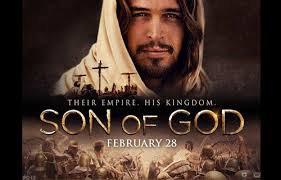
Summary review
I seldom watch movies, I generally have other things I would rather do. But I made an exception yesterday for the movie, Son of God. My wife and I went with Harrison and Carol Griffin to a theater and watched it.
The movie is made from scenes from the Bible series. This allowed the directors also to set the movie with earlier clips such as scenes from the birth narrative – clips that gave Son of God greater “sitz im leben,” to use a German theological phrase. The phrase means the clips at the beginning set it in life and culture and times much better than if it had just started at the adult ministry of Jesus.
The Moroccan countryside used for the filming seemed so fitting. As one who lived and traveled in Morocco for three years, I was aware of how much the countryside there reminded me of the Biblical narratives. This movie only added to that feeling. Yet, the time transport, so to speak, was so good that it became a double-edged sword. On the one hand, it depicted well the conditions, clothes, culture, etc. of Jesus’ day. But on the other hand, it removed the story from mine and made it just a little harder to identify with the real life drama in the lives of Peter, Jesus, John, Judas, two Mary’s, Caiaphas, and Pilate.
Overall, I found watching the movie to be a powerful faith experience. I sat in silence for some time afterward, not wanting to talk or be spoken to, just absorbing the impact of what I had seen. It reminded me of what I knew from the Bible, forcefully bringing to mind the Biblical stories and pushing me to interact with them emotionally and spiritually. There is so much about Jesus to admire in the film, as there should be, his wisdom, his power, compassion, fairness, his lack of fear of power. Most of all, one admires his courage to go to the cross knowing that it was coming. This is true to the Biblical narrative as he predicted his coming death at the hands of the Jews.
I recommend the movie. If a person knows little about the Bible, it will educate. If a person knows much, it will remind and challenge. But most of all, it will help you all to be inspired by Jesus. I recommend taking friends as it will provide opportunities for discussion and for the Holy Spirit to work in the minds and hearts of people. It is not perfect as many liberties have been taken with the biblical narrative, but it is definitely inspirational. I recommend reading the Gospel of John again to compare and answer questions. For those of my readers who haven’t seen it yet, I suggest you stop reading here and go see it. Then come back and read my more detailed comments that follow.
My favorite vignettes:
1. The depictions of the Sea of Galilee with its first century boats were excellent. The scene where the disciples are caught in a storm and Jesus invites Peter to walk on the water is so well done. It is Biblically true, very convincing, and it captured the true sense of Jesus inviting Peter to experience the power of faith.
2. The calling of Matthew is very moving. It shows Jesus’ ability to see the person, to override the perspective of both friend and foe in order to find the healing wholesome, kingdom enhancing path.
3. The scene of the woman caught in adultery was so powerful. While I did not hear a mention of the sin of which she was accused, nor did Jesus write on the ground during the pregnant silence as he did in Scripture, one still got the message clearly that in our treatment of those who error, we must be aware of our own sins and work for restoration.
4. I really like the fact that Mary Magdalene was included in the scenes with the disciples. The Bible mentions that there were a few well-to-do women who traveled with the disciples (Luke 8:1-3). Mary was one of them. The film narratives involving her are all created for the movie but her inclusion is a plus.
5. I thought the movie accurately portrayed the political tension between Pilate and the Jewish leaders. While most of the narrative was fictional, it reflected the situation which the Bible depicts.
6. Overall, I appreciated the Last Supper scene because it had a real sense of the drama and importance of the moment. The interaction of Jesus with the disciples is rich with feeling.
7. My wife and I were both particularly struck by the powerful juxtaposition of the three prayers during the Gethsemane sequence. All were sincere in their own way. But Jesus was the only one truly in touch with God and living out his faith morally and with integrity. Both Caiaphas and Pilate found it acceptable, even rationalized that it was proper, to accept compromise of what they knew was right to protect their positions. Obviously, the prayers of Caiaphas and Pilate’s wife are not in the Bible but the film’s deliberate contrast caught the message of the NT that Jesus came into this world to introduce a kind of piety that surpassed the hypocrisy and idolatry of his day.
Concerns:
1. There were many times that closeness to Scripture was compromised. Often I felt the Scripture’s story line was more powerful. The most egregious example for me was in the scene depicting the raising of Lazarus. Not only did they miss the important verse about Jesus weeping at the grave, but what is this kissing his dead head business? It is quite clear in Scripture that Jesus did not enter the tomb of Lazarus, nor did anyone else. Jesus shouted from outside the tomb, “Lazarus, come out!” The Bible says that Lazarus came out still bound in grave clothes that had to be removed by celebrating friends. To me the Bible’s version has far more drama. I really wish the movie had followed the narrative of John 11 much more closely.
2. Simply from a story point of view, the film’s portrayal of Nicodemus was enjoyable and appropriately complex. But it was also about 90% conjecture. For example, there is no indication in Scripture that Jesus’ questioner concerning taxes was Nicodemus or that the questioner was sent directly by Caiaphas. In fact there are only 3 mentions in the Bible of Nicodemus. The night visit to Jesus is recorded but it occurs first of the three incidents in John’s gospel (John 3:1-15) rather than later as in the film. Second is the interaction with the high priest (John 7:50-52). The film inexplicably omitted the priest’s comment about Galilee, even though it had been set up well by the laugh scene when Jesus’ Galilee location is first mentioned to Caiaphas. Last, after Jesus is dead, the Bible says, Nicodemus accompanied Joseph of Arimathea in asking Pilate for the body of Jesus (John 19:38,39). I use this as an example of the fact that the person watching the film must be constantly aware that what you are seeing in the story lines is a mix of Scripture and created narrative. In the case of Nicodemus, Caiaphas, Mary Magdalene and Pilate, much of it is fictionalized to make the movie work.
Missed Opportunities:
Another thing I could not help but note as I watched the movie was the missed opportunities to include powerful stories from the NT that were closely related to those that were included and would have revealed great additional information about the Son of God. I’m sure that one of the key reasons why some of the following were missed was editing to reach an arbitrary time length goal for the film. But these omissions are nearly inexcusable.
1. There was no little boy in the feeding of the 5000 scene. It would have added to the human drama of the scene and portrayed Jesus as the lover of children that he was. The boy is mentioned in John’s gospel too (6:9).
2. In the Upper room scene, the movie omitted Jesus washing the feet of the disciples, another unique part of John’s gospel narrative in the Bible (John 13:1-17). By that act Jesus taught humility, modeled servant leadership and countered bickering among the disciples. It should have been included.
3. The conflation of the two Sunday night appearances of Jesus in the film made for several missed opportunities. According to the Bible, on Easter night, Thomas was not there when Jesus appeared in the room. The next week Jesus appeared again and Thomas was there. Separating the two appearances of Jesus as in the Bible would have made Thomas’ unbelief more credible and contextual. The upper room door was locked when Jesus appeared, a fact the film misses too. The opportunity was missed also for Jesus to breathe on the disciples and give them his Spirit (John 20:22). In addition, he assigns them his mission in that upper room.
4. I was amazed the movie did not include the John 21 scene of Jesus appearing to Peter and the disciples on the beach. The scene was all set up in the film by the treatment of the three denials and Peter’s bitter remorse. It speaks of Jesus’ forgiving nature. The Bible story also features John, the apostle who narrates the film, providing another needed touch point with him, which the film needs. Including this scene would have added another post resurrection appearance to the film as well, something the film also needed.
Recommendation
As I said in the beginning, I recommend this film. It is not perfect. There are scenes I wish had been tweaked and others I wish had been included that were not, but still, even with these considerations fully in view, I believe the film will have the wholesome effect of building up its viewers in faith and in admiration for Jesus. I pray that it also invites and pushes all of us to read our Bibles more so we can get the Apostle John’s story first hand, from the pen of the writer. To use a modern cliché intentionally, “The book is even better!”
 Now they’ve done it! They changed my favorite verse, my life verse. “And God is able to make all grace abound to you, so that in all things at all times, having all that you need, you will abound in every good work (2 Co. 9:8 1984 NIV) becomes “And God is able to bless you abundantly …. (2011 NIV). At first I felt the gut reaction of reading a new translation. It is different. I resist change to that to which I have become accustomed and especially hold dear. But then I thought about the new version. It’s so accessible to the uninitiated, so immediately plain; it requires no accompanying explanation of the varied meanings of the word grace in the NT in order to understand it. I could not help but be impressed that for many readers, probably for most readers, the new version was more understandable, more in today’s language. That is really the point of this new translation in a nutshell. And I could not help but approve, in spite of myself.
Now they’ve done it! They changed my favorite verse, my life verse. “And God is able to make all grace abound to you, so that in all things at all times, having all that you need, you will abound in every good work (2 Co. 9:8 1984 NIV) becomes “And God is able to bless you abundantly …. (2011 NIV). At first I felt the gut reaction of reading a new translation. It is different. I resist change to that to which I have become accustomed and especially hold dear. But then I thought about the new version. It’s so accessible to the uninitiated, so immediately plain; it requires no accompanying explanation of the varied meanings of the word grace in the NT in order to understand it. I could not help but be impressed that for many readers, probably for most readers, the new version was more understandable, more in today’s language. That is really the point of this new translation in a nutshell. And I could not help but approve, in spite of myself.






